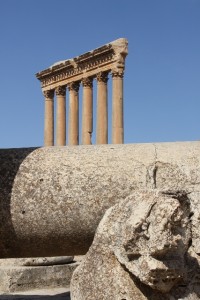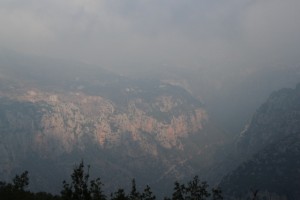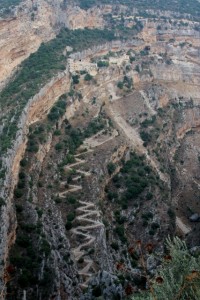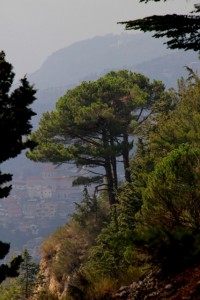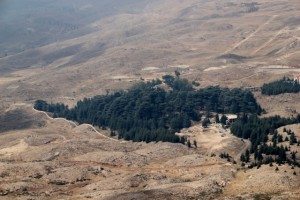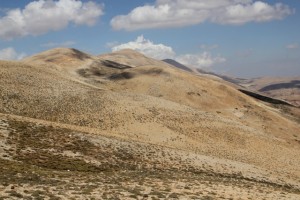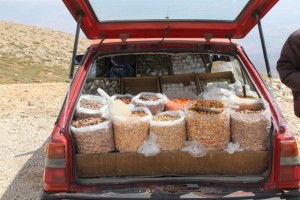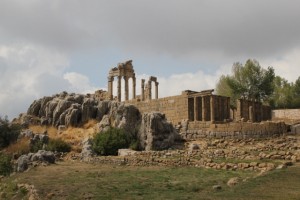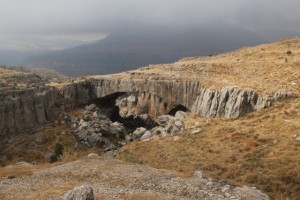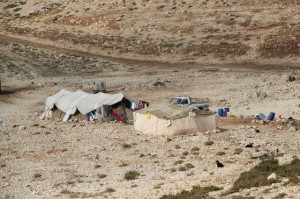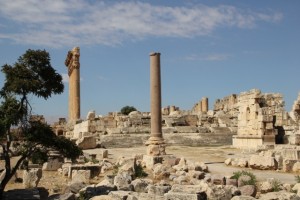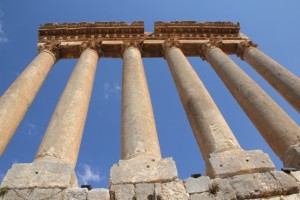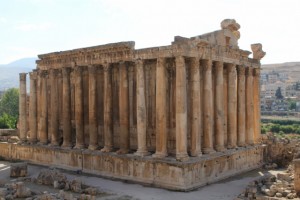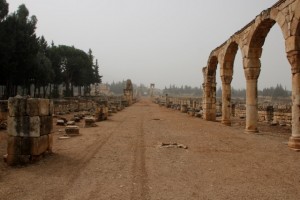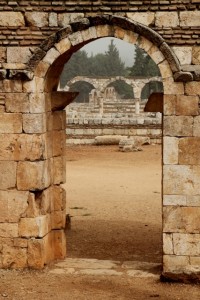Away from the coast one crosses Mount Lebanon, with the remains of its once famous cedar woods, into the Bekaa Valley, home of the spectacular Baalbek ruins from Roman times and the ancient Muslim city of Aanjar.
Mount Lebanon is the mountain range that divides Lebanon in an overcrowded Western coastal strip and an empty, Eastern fertile valley. But Western and Eastern does not only refer to the geographical sides of the mountain, it also defines a cultural split. The coastal strip is modern, comparatively rich, and remarkably un-Arab, for want of better description. Across the mountains the Bekaa Valley, and especially the northern part of it, reminded us of SE Turkey, and I can imagine Syria looking like this, too. Simple villages, predominantly agricultural society, and devout Muslim.
But before we get to the Bekaa Valley we need to cross the mountains, in places up to 3000 m high. There are several roads, generally in good condition, and perhaps the most used is the northern one, which goes past the Quadisha Valley to the ski resort of The Cedars.
The Quadisha Valley is an essential part of seeing Lebanon. A rather inaccessible, deeply eroded canyon, it was the ideal place to hide – which is what many of the persecuted Christians did in the Middle Ages, in the process establishing hermit churches and monasteries, often precariously perched on narrow ledges in the mountain side. Nowadays one can track through the Valley, and visit many of the churches, which will take most of the day, if not more. Unfortunately, when we passed the weather was bad, threatening to rain and thunder, and the valley closed in by clouds. The only exposure to the Quadisha Valley we got were the views from the north wall of the valley whenever the sun broke through, and the monastery at the other side of the river, built high up in an anticline, and reached only by a steep set of stairs from the valley floor (and a secret road, with metal stairs down, from somewhere else, but that would be too easy, no?).
In fact the view of the monastery was from the terrace of one of the weirdest museums I have ever seen, the stone museum, where some hobbyist had created puppets out of stones, painted them, and displayed them, in a garden behind a strange, rather ugly round stone tower. In fact, everything was stone here, the tables, the floor with varying kinds of marble, modern mosaics.
Bcharre, the main town at the apex of the Quadisha Valley and the usual base for tracking, was also a pretty bleak experience on a weekday outside the tourist season, the town being totally deserted, everything closed. Just above Bcharre is the Quadisha grotto, a relatively small limestone cave, nothing compared to the Jeita grottos visited earlier – but also the tourist density was nothing compared to Jeita, for most of the walk to the end of the cave we were alone.
A little further along is The Cedars, not only Lebanon’s oldest ski resorts, but also famous for its cedar trees, Lebanon’s national symbol. In fact, if not for the tourist stalls along the road, we would have missed it. Where we had expected enormous forests of trees, whole mountain slopes covered – no doubt the way it was, very long ago –, there is now little more than a small grove of green trees left, walled to prevent illegal logging. Good for skiing, these empty slopes, but this cannot have been the intention. And not just here, everywhere along the mountains there are just very few old trees left. Earlier, we crossed the entire Barouk forest in the Chouf Mountain Cedar Reserve, further south, on foot in less than 15 minutes, walking in a circle. So much for the term forest! Here, too, the rest of the mountain slope is bare, save the occasional planting of young new trees, all neatly arranged. (94-378: Young cedar trees neatly arranged in the Barouk Cedar Reserve) And although the Lebanese will want you to believe that the Israeli army chopped down the cedars, during their invasion, but this process must have started much earlier than the occupation in 1982 – no army, not even the Israeli army, can chop down such vast mountain slopes as have been laid bare here. Indeed, Nebuchadnezzar already wrote on a stele at the Narh al-Kalb in around 1500 BC that he now had unlimited access to supplies of cedars.
From The Cedars, it is not much further to the pass that leads to the Bekaa valley, a desolate road across the mountains, that, however, from the top, at what, 2000 meters or so, provides great views.
An equally attractive crossing is further south, from the village of Achkout. This is where part of Sofia’s family comes from: great-great-grandfather Hanna (John) Felix emigrated just over 100 years ago, with one of his sons, Sofia’s great-grandfather Mansour – who called himself Feliz in Argentina. The village is located at the top end of two valleys, and is, at around 1000 m altitude, pleasantly cooler than down in Beirut. The road from here across the mountains passes the Quab Fakra Roman ruins, and – this took a little more effort to find – a quite spectacular natural bridge, also called Fakra.
A little higher is Faraya, another ski area. All over the slopes are the lifts, and in winter this must be quite a major resort, but in September it is deserted, rather depressing. Hundreds of Quads, obviously the preferred way of transport during the winter, are parked beside the empty hotels, on for the rest empty parking lots.
The last part to the top of the mountain range, and the drive down on the other side, is through barren rock – limestone – country, sparsely inhabited by herds of goats, ferocious dogs accompanying them, and by groups of Bedouin. These days they operate with pick-up trucks rather than with camels or other pack animals. They have established themselves in groups of tents, made of an odd collection of blankets, rugs, and other cloths. You wonder whether they could not get something more durable, or perhaps easier to set up, but I suppose this is what they are used to, what they have always used; anything more modern might as well be replaced by an apartment straight away.
Entering Bekaa, one enters a different world, at least in the northern part of this valley. Where the coastal side of Mount Lebanon is quite well developed, in terms not only of living standards, and associated prices, but also as far as construction goes – apartment buildings all the way up the mountain slopes -, Bekaa is different, much less populated, more humble. The valley itself is broad and flat, seemingly everything can grow here, and does. The grapes for the local wines are most obvious, but there are also all sorts of fruit trees, vegetables, and huge potatoes. When the French created Lebanon – when they split it off from Syria -, they may have wanted to protect the Christian inhabitants from Arab Muslim domination, but they must also have been aware of the years of famine that Lebanon went through during the First World War. Which is why they made it much larger than strictly necessary, they extended the country to the south and they included the Bekaa valley, to ensure sufficient food production.
The place most tourists most commonly associate with the Bekaa Valley is Baalbek. Baalbek itself is nothing special, a small town in the valley, but it has a few things that make it special. Firstly, and most recently, this is the headquarters of Hezbollah, the Iran-backed organization, or political entity, or militia, or terrorist group – they have been called many names, probably all ringing true to a certain extent, depending who you talk to. Secondly, it has the Palmyra Hotel, one of those magnificent colonial relics that you would normally find in India, or so. Carpeted corridors and stairs, kilims on the walls, large sofa sets in the communal rooms, drawings and old photographs on the wall, massive chandeliers, and the highest hotel rooms I have ever seen, must have been 5 meters or more (which is why they hadn’t been painted for a long time, they don’t have ladders tall enough). This must have been quite a place in years past. Every important person that has been to Baalbek stayed here – perhaps because there was no other option, but that aside. The hotel was requisitioned by the Germans in WWI, and by the allies in WWII. Now it is mostly faded grandeur. The rooms are not very clean anymore, and not that well maintained – peeling paint, molded bathroom ceilings. The doorman and the sweeper seem to be from its heydays, both are pretty old, and can certainly not carry heavy suitcases up the stairs anymore. Yet, the place still has a lot of character, a lot of atmosphere left. And on one side the rooms have a balcony with view over the third reason Baalbek is special – the reason, also, that the hotel is here in the first place -, which are the Baalbek ruins. Nobody had prepared us for this. Of course, guide books and travel writers had spoken of the complex in the most positive descriptions possible, something special, unique, but that didn’t prepare us for the experience. Here, in the middle of nowhere, really – if you can call the small town of Baalbek itself “nowhere” – stands this enormous Roman complex, built on earlier Phoenician and Hellenistic structures, with large parts of temples having withstood earthquakes and other destructive forces, like Tamerlane, like the Mameluks, the usual suspects. Not to speak of the Israelis, of course, who are universally blamed for all the damage in this country. There are still six twenty-meter high pillars remaining from the Temple of Jupiter, there is an almost intact Temple of Bacchus, beautifully decorated in Roman times, and further adorned by graffiti from 18th and 19th Century travelers, who felled compelled to add their names to the walls. The impressively constructed walls of the Great Court contain fabulous niches – which must have held the most exquisite sculptures in the past. And there was nobody else but the two of us!
Baalbek itself is not very interesting, there is a small souk, a few antique shops selling mostly newly made artefacts and other tourist souvenirs, and no restaurants to speak of: we were reduced to eating shoarma and falafel, and that all pretty early in the evening, because the eateries, if you can call them that, were closing early. This being a Muslim dominated town, there was also no alcohol in the bars, only alcohol-free beer, but we did manage to find a small shop that sold wine, whiskeys and arak, the local Lebanese anis-based drink. We bought ourselves a bottle of arak (which we subsequently polished on the long evening on the hotel balcony); the wines didn’t look to promising. They had been there for a while, no doubt, but I have so my reservations about storage. It wouldn’t surprise me if the 1987 Fleurie hadn’t moved since it arrived in this Baalbek off-licence, and has for ever been standing there, upright, in the heat of the day.
Further down the Beeka Valley is Aanjar, towards the Syrian border. The complex of ruins here may have had a Roman origin, but what is left are the remains of a 8th century Umayyad Muslim settlement, possibly a trading town. Traces of many shops have been found, and can clearly be seen in the present set-up, along the two main roads that divide the town in four quarters. In one of the quarters are the remains of a palace, with high vaulted arches and pillars, which must have been quite a sight, before most of it collapsed from the usual suspects – raiding enemies and earthquakes.
Continue: Back to Beirut
